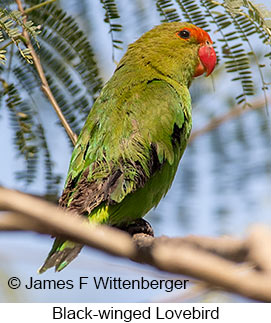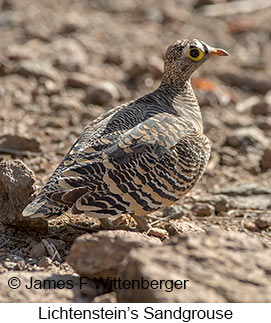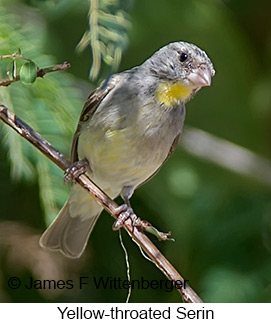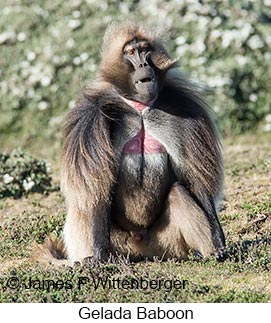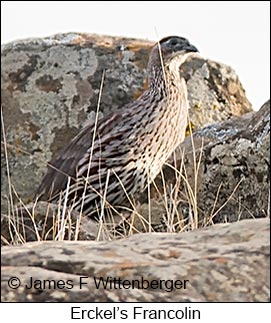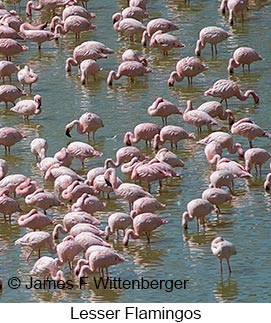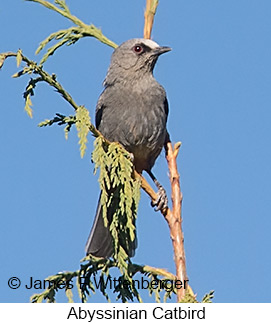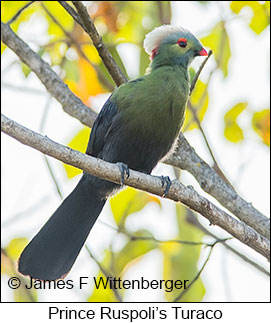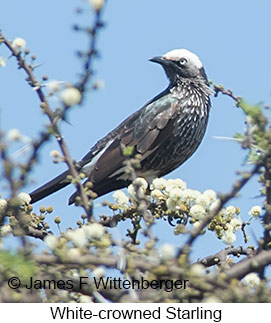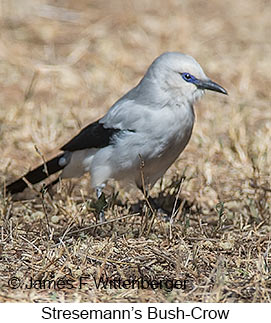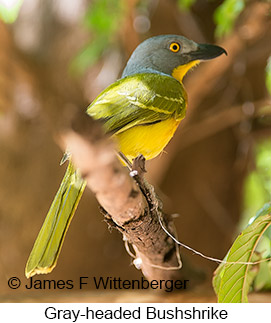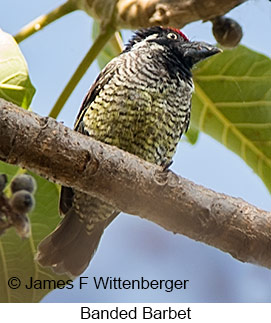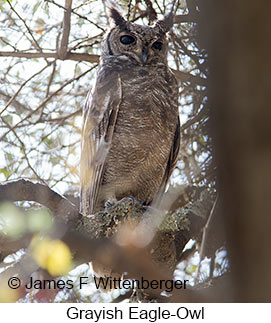ETHIOPIA BIRDING TRIP REPORT

TRIP REPORT
ETHIOPIA
| Start: | 01/01/2019 |
| End: | 01/19/2019 |
| Duration: | 19 days |
| #Species: | 397 |
| #Endemics: | 35 |
| #Heard Only: | 0 |
2019 Ethiopia Scouting Trip
TOUR DESCRIPTION
My scouting trip to Ethiopia was planned to cover the main birding areas visited by typical tours to the country. These are all located in the center of the country and include part of the Rift Valley, highlands north of Addis Ababa, lakes south of Addis Ababa, the Bale Mountains, and the less arid south around Negele and Yabelo. A typical tour usually records 500-540 species depending on season and local conditions. We recorded substantially fewer in part because I spent substantial time doing photography, in part because we lost a day of birding around Negele due to stomach problems I had after eating a lunch in Awassa, in part because January is not the best possible month to visit, and in part because conditions were extremely dry and bird activity was unusually low. After this trip, I adjusted the itinerary to make better use of the time as I felt a couple days on my scouting trip could have been better spent elsewhere.
I arrived in Addis Ababa a couple days early to adjust for the time change. On the first day of the tour I was picked up at my hotel near the airport and transferred to Babogaya Lake Viewpoint Lodge in Bishoftu south of Addis Ababa. After arrival and check-in, we visited nearby Lake Chelekleka and also a stakeout location for Grayish Eagle-Owl in town. The owl wasn't present as it was a Sunday and many people were around the hotel where it often roosts. At the lake water levels were very low and most aquatic birds were very far from the trail along the lake edge. The most important species there are Common Crane and Black Crowned-Crane, present but very far from us. We then visited some dry forest around Lake Hora north of town, which we also visited again in late afternoon. Most notable birds we saw there were Yellow-billed Stork, African Marsh-Harrier, Black-winged Lovebird, Red-fronted Tinkerbird, Banded Barbet, Red-throated Wryneck, Tree Pipit, Rüppell's Robin-Chat, Common Redstart, African Paradise-Flycatcher, White-shouldered Black-Tit, Tacazze Sunbird, Northern Red-Bishop, and African Citril. After lunch in early afternoon we drove out of town to some arid pastureland where we had distant views of Black Crowned-Crane and saw Spur-winged Goose, Blanford's Lark, Reichenow's Seedeater, and Cut-throat.
On day 2 we drove east through arid scrubland and down the western escarpment into the Rift Valley. Along the way we saw Wattled Cranes in flight, an Egyptian Vulture, our first of many Tawny Eagles, and a Rufous-crowned Roller perched on a power line. We took a side road to pick up the scarce Yellow-breasted Barbet and also saw a juvenile African Harrier-Hawk and a raucous group of Black-billed Woodhoopoes. We later stopped at a lava bed where we eventually had good views of our main target species, Sombre Rock-Chat. We also saw Blackstarts and a Striolated Bunting there. We arrived at the main visitor area of Awash National Park in time for lunch. The restaurant overlooks a canyon and a lovely waterfall. Along the access road into the park we had good views of Abyssinian Roller on a wire along with Eastern Chanting-Goshawk and Woodchat Shrike. We also saw Salt's Dikdik and had a rare daytime view of the normally nocturnal Common Genet, which bounded off after staring at us for a couple minutes. In the afternoon we did a game drive through the park. The region is much drier than just a few years ago and mammals such as African Elephants that were previously present are now extremely scarce or absent. Mammals we did see were Soemmerring's Gazelle, Beisa Oryx, Abyssinian Scrub-Hare, Warthog, and Olive Baboon. Notable birds were Kori Bustard, Buff-crested Bustard, White-bellied Bustard, Chestnut-bellied Sandgrouse, White-bellied Go-away-bird, Blue-naped Mousebird, Abyssinian Scimitarbill, Abyssinian Ground-Hornbill, Red-faced Crombec, Rosy-patch Bushshrike, Somali Fiscal, and Red-billed Buffalo-Weaver.
We spent all of day 3 birding in Awash National Park. At first light we walked a road and trail near the lodge. We picked up a couple Slender-tailed Nightjars before they went to roost. We also saw Emerald-spotted Wood-Dove, Eastern Plantain-eater, Ethiopian Boubou, White-rumped Babblers, Rüppell's Starling, and Swainson's Sparrow along with Lesser Kudu and groups of Vervet Monkeys and Mantled Guerezas (also called Abyssinian Black-and-white Colobus monkeys). After breakfast we drove a variety of dirt tracks accompanied by a park ranger. New birds of interest we saw were Gabar Goshawk, Yellow-necked Spurfowl, Arabian Bustard, Black-headed Lapwing, Lichtenstein's Sandgrouse, which we were very lucky to see quite close to the road, Red-fronted Barbet, Red-fronted Warbler, Grayish Flycatcher, Nile Valley Sunbird in good light, Ethiopian Boubou, and Wattled Starling. We also saw a large troop of Hamadryas Baboons as they crossed an opening between two sets of thickets and a race of baboons that is basically a cross between Olive and Hamadryas Baboons.253We left the lodge in Awash after breakfast on day 4, transferring to nearby Aledeghi Wildlife Reserve, an area even more arid than Awash though part of the reserve is quite green. The arid section is ideal habitat for Arabian Bustard and we saw several. It's also habitat for Gerenuk, a strange long-necked antelope adapted to reaching vegetation out of the reach of competing gazelles and dikdiks. The Genernuks there are very shy even at considerable distance. We saw two. We spent much of the day at Aledeghi. Notable birds included Senegal Thick-knee, Spur-winged Lapwing, Striped Kingfisher (a single female), European Bee-eater, Eastern Yellow-billed Hornbill, Yellow-breasted Barbet, Black Scrub-Robin, Black-eared Wheatear, Northern Crombec, and African Silverbill. We then transferred to Awash town for a night at a hotel there.
After early breakfast on day 5 we left for the highlands, driving up the western escarpment of the Rift Valley into the highlands. Before reaching the road up we did some roadside birding and picked up Black-chested Snake-Eagle, African Hoopoe, Black Scimitarbill, Red-bellied Parrot, Black Scrub-Robin, Slate-colored Boubou, and Eastern Paradise-Whydah. Mid-way up the pass we stopped near a ravine area that is the best place to see the endangered Yellow-throated Serin. With a little patience we had very good views of it. We also saw a variety of other species there including Yellow-breasted Barbet, Eurasian Kestrel, Northern Crombec, Black Wheatear, Isabelline Wheatear, and Mariqua Sunbird. From there we continued on to the Kesem River, a birding hotspot. There we picked up Senegal Thick-knee, Three-banded Plover (a target species there), Blue-spotted Wood-Dove, Eastern Plantain-eater, Half-collared Kingfisher (another target species and quite secretive), Gray Wagtail, Mountain Wagtail, Rufous Chatterer, Brubru, Yellow-throated Serin, Reichenow's Seedeater, and Village Indigobird. Farther up the pass we saw many White-collared Pigeons. We spent that night at a nice hotel in Debre Birhan.
Day 6 was an important day, looking for Ankober Serins. We were high on the Ankober Escarpment by 7:00am. The serins move between roosting grounds and feeding grounds and are difficult to find later in the day on their feeding grounds on the plateau. We saw just two flying overhead, and not very good views. Another attraction are the many Gelada Baboons, a strange, long-haired primate that lives in large groups, roosts on the cliffs of the escarpment, and then feeds in the montane meadows during the day. Also present and seen were a very distant view of Verreaux's Eagle on a far cliff face and soaring below the escarpment, Wattled Ibis, Augur Buzzard, Cape Crow, Thick-billed Raven, Plain-backed Pipit, Red-throated Pipit, Moorland Chat, Streaky Seedeater, and Ethiopian Siskin. In mid-morning we left the escarpment area and birded the grassland and scrub of the high plateau. We had distant views of a Bearded Vulture (Lammergeier) in flight. Other notable birds included Blue-winged Goose, Black-winged Lapwing, Abyssinian Woodpecker, an increasingly rare and difficult species to see, Blanford's Lark, Ethiopian Cisticola, White-winged Cliff-Chat, Red-breasted Wheatear, Ethiopian Thrush, Ethiopian Siskin, and Yellow Bishop (in non-breeding plumage). In mid-afternoon we drove the road down into the Jemma Valley. We had very limited time in the valley, just a couple hours in the afternoon. We did see Speckled Mousebird, Mocking Cliff-Chat, Scarlet-chested Sunbird, and Speckled-fronted Weaver along the road. At the river we saw a number of widely distributed species but also Senegal Thick-knee, Spur-winged Lapwing, Black-breasted Barbet, Pied Kingfisher, and Bush Petronia. On the way back up the road, we had brief views of Erckel's Francolin.
On day 7 we left our hotel at 5:40 to reach the best site for Harwood's Francolin before dawn. This very shy species is best seen at first light as it descends from its roost sites on the cliffs to its feeding areas in rocky moorland off the road. We had several brief, distant views of this species as it scurried among the rocks. After viewing the francolins, we had good looks at Black-crowned Tchagra and higher up the road Erckel's Francolin and Ortolan Bunting. After breakfast we drove across the plateau to the Ethno-German Lodge, arriving at 11:15am. En route we picked up African Black Duck, Pallid Harrier, Pied Crow, Pied Wheatear and saw many Ethiopian Thrushes. The Ethno-German Lodge overlooks a canyon where various vultures and raptors soar above. We saw several Bearded Vultures and Rüppell's Vultures. A troop of Gelada Baboons was feeding near the lodge. Other birds we saw were Hemprich's Hornbill, Mountain Gray Woodpecker, and White-rumped Babbler. From there we continued on to the Sululta Plain, a wetland area en route to Addis Ababa. There we saw a variety of wetland birds and open country birds including Blue-winged Goose, Spur-winged Goose, Wattled Ibis, Lappet-faced Vulture, Peregrine, Pied Wheatear, Red-billed Oxpecker, and Ethiopian Siskin. We spent that night back at Lake Viewpoint Lodge in Bishoftu.
We departed after breakfast at 8:00am on day 8 for Lake Ziway and later Abidjatta-Shala National Park. Our first stop was Lake Koka where we picked up Goliath Heron, Hottentot Teal, Long-crested Eagle, Woodland Kingfisher, and a variety of other widely distributed species. En route to Lake Ziway we had excellent views of Northern Carmine Bee-eater along the road and Red-throated Pipit near a small wetland. At Lake Ziway notable birds seen there were Black Heron, performing its unusual, umbrella-like hunting behavior, Fulvous Whistling-Duck, White-faced Whistling-Duck, Comb Duck, Lesser Sand-Plover, Common Snipe, Black-tailed Godwit, White-winged Tern, Malachite Kingfisher, Sedge Warbler, and Tawny-flanked Prinia. We also saw a female Greater Honeyguide, the first time my guide had seen a female, in some trees near a pasture along the road to the lake. In the same pasture area we saw White Wagtail, African Pied Wagtail, Plain-backed Pipit, Beautiful Sunbird, and Red-billed Oxpecker. After lunch at a hotel near the lake, we continued on to Abidjatta-Shala. As we approached our lodge we had our first distant views of the some 10,000 Lesser Flamingos and Greater Flamingos that line the shores of Lake Abijata. After arrival we had some time for afternoon birding and picked up Gabar Goshawk, Crested Francolin, Red-fronted Barbet, Nubian Woodpecker, Bearded Woodpecker, Rattling Cisticola, Buff-bellied Warbler, White-winged Black-Tit, Yellow-spotted Petronia, and Common Waxbill.
We spent all of day 9 birding around 10,000 Flamingos Lodge in Abidjatta-Shala National Park. Birds of interest we picked up were Cape Teal, Western Marsh-Harrier, Crowned Lapwing, Lichtenstein's Sandgrouse, Grayish Eagle-Owl, Black-billed Barbet, Yellow-bellied Eremomela, and White-rumped Seedeater. We found fresh signs of Aardvaark where it had been feeding near the lodge the previous night, so we went out after 9:00pm looking for it with no luck. We later learned that Aardvaarks are very shy and don't come out until around midnight after all human activity around the lodge has ceased.
We left the lodge on day 10 about 8:00am en route to the Bale Mountains, a quite long drive. En route we stopped at a ravine that was a stakeout for Cape Eagle Owl and found it perched quite far from us. Next stop was the Gaysa Grassland inside Bale Mountains National Park. We had distant views there of Bohor Reedbuck and Mountain Nyala grazing quite far off the road. At a pond near the road we had good views of Southern Pochard, Rouget's Rail, and Spot-breasted Lapwing. Continuing on to the park headquarters area we birded some good forest ggand with the help of a local guide who met us in town, we had brief views of Abyssinian Catbird followed by good looks at White-cheeked Turaco, White-browed Robin-Chat, White-backed Tit, and Yellow Bishop (in non-breeding plumage) along with quick views of a group of Chestnut-headed Francolins crossing an open area and a brief view of a flying Booted Eagle above the clearing we were in. We then visited stakeouts of African Wood-Owl and Abyssinian Owl. We spent mid-day at our lodge before going out again at 3:30pm. In the afternoon we revisited the grassland where we had stunning views of Abyssinian Longclaw.
Day 11 was devoted to the Sanetti Plateau, high in the Bale Mountains National Park with an altitude reaching over 13,000 ft. The plateau is home to one of the four extant populations of Ethiopian Wolf, the largest of the four. We soon spotted Augur Buzzard, Little Sparrowhawk, and Chestnut-naped Francolin. As we reached the first section of the plateau before we were in wolf habitat we spotted a distant predator standing looking at us in an open meadow. It was an extremely rare sighting of a Serval cat. Not long after that we spotted a couple distant Ethiopian Wolfs, which are typically seen mainly some distance off the road. We took a side road to a trail leading to a lake that is the best place to find Wattled Crane. Unfortunately, the cranes were absent, a major miss. We did see Red-billed Chough, a high elevation corvid found only locally throughout its range, along with a number of Ruddy Shelducks. Back on the main dirt road we spotted another distant Ethiopian Wolf along with Lesser Spotted Eagle, a couple dark phase and a couple light phase Augur Buzzards, Crowned Eagle, Lanner Falcon, and Cape Eagle-Owl. The road eventually descends from the plateau into the Harrera Forest. Birding is difficult in the forest as birds are scarce and not very active at least out side breeding season but we saw a variety of species along the road and while walking a pasture area adjacent to the forest reached from the access road to the Bale Mountain Lodge located there. Species seen included Black Sawwing, Cinnamon Bracken-Warbler, Abyssinian Slaty-Flycatcher, Yellow-crowned Canary, Baglafecht Weaver, Yellow-bellied Waxbill, and Pin-tailed Whydah. We then retraced our route back across the plateau, and on the way back we spotted an Ethiopian Wolf drinking water from a small waterhole next to the road followed by 4 more wolves crossing the road less then 30 ft in front of us. We spent a some time watching them until then wandered off into the bush. As we descended from the plateau we stopped in a forest area where we soon had wonderful views of Abyssinian Catbirds flying among some open trees.
Due to problems in the south, we couldn't take the usual shorter route from Bale to Negere. Instead we had to backtrack on day 12, which took most of the day since we did some birding en route. While still in Bale National Park we had good views of Moorland Francolin along the road. We also saw a Common Duiker. After lunch in Awassa, we continued on toward Negele, stopping in a wet pasture where we spotted 3 Wattled Cranes, extremely good luck after missing them on Sanetti Plateau. At a stakeout location we found two Prince Ruspoli's Turacos, a highly localized target species. In the same location we also saw our first Silvery-cheeked Hornbills. We finally arrived in Negele about 5:30pm.
Day 13 was supposed to be spent seeking out a few target species around Negele, namely the endangered Liben Lark along with other more widely distributed species. However, I suffered 24 hours of diarrhea caused I believe from contamination of the lunch I had in Awassa the previous day, so I was in no condition to go out birding this day and we missed trying for the lark.
We left at 6:20am on day 14 for the long drive to Yabelo. The drive generally takes all day because various sections of the road are either in very bad condition or undergoing construction to upgrade the bad conditions.There wasn't much birding en route but we did see Woolly-necked Stork, White-headed Vulture, and Long-crested Eagle. We arrived at 5:00pm. After check-in we found African Black-headed Oriole outside our rooms on the hotel grounds.
On day 15 we left the hotel at 4:20am for the hour plus drive to some cliffs where it's possible to see the rare and difficult to see the endangered Black-fronted Francolin. It's a difficult bird to see among the boulders at some distance and is best seen around first line. My guide picked it up but I never saw it. Other birds seen there included Klaas's Cuckoo, Slate-colored Boubou, White-crowned Shrike, Bristle-crowned Starling, Red-winged Starling, and Compact Weaver, Yellow-spotted Petronia. We then drove back towards the nearest town for breakfast. After breakfast we birded dry scrub areas along the road back toward Yabelo as well as some side roads into the scrub. Notable birds seen included Three-banded Courser, Bearded Woodpecker, Foxy Lark, Banded Parisoma, Yellow-breasted Apalis, White-browed Scrub-Robin, Rufous-tailed Rock-Thrush, White-bellied Seedeater, and Somali Bunting. Along a side road not far from Yabelo we added many additional species including Secretarybird, Bateleur, Red-bellied Parrot, Red-billed Scimitarbill, Black-throated Barbet, Lesser Honeyguide, Abyssinian Roller, Yellow-vented Eremomela, Red-faced Crombec, Stresemann's Bush-Crow, White-crowned Starling, and Black-capped Social-Weaver. Following lunch at a restaurant in town we birded some dry open forest outside town where we saw a distant Gerenuk along with Lesser Striped-Swallow, the endemic and uncommon White-tailed Swallow, Long-billed Pipit, and Taita Fiscal. We then drove back out to an area where we had tried for and missed Red-naped Bushshrike during the morning and with some persistence we had good views of it. We also saw Grosbeak Canary in the same place. We returned to the hotel about 5:00pm and saw had good views of Gray-headed Bushshrike and a pair of Abyssinian White-eyes in a tree outside our hotel rooms.
We left Yabelo around 7:30am after breakfast on day 16 for some birding away from town. Outside town we had good views of White-browed Coucal. Our first stop was some dry forest along the road to Borana Lodge. There we had good views of Pygmy Falcon, Eurasian Hoopoe, d'Arnaud's Barbet, and Lilac-breasted Roller. We then continued birding the highway leading back toward the site visited the previous day where we hoped to see Red-naped Bushshrike. En route we saw Somali Ostrich and Burchell's Zebras. At the bushshrike site we did finally see the bushshrikes but only fleeting views or obstructed views that made photography difficult. In the same place we also saw Somali Tit, Scarlet-chested Sunbird, Black-cheeked Waxbill, and Green-winged Pytilia. On the way back to Yabelo we had good views of Crested Francolin along the road and crossing the road in front of us. On a side road leading to a Save the Children enclave, we had decent views of the endemic and quite uncommon White-tailed Swallow mixed in with Barn Swallows. We also saw Eastern Chanting-Goshawk, Gabar Goshawk, Pearl-spotted Owlet, and many endemic Stresemann's Bush-Crows. In mid-afternoon at the hotel we saw Gray-headed Bushshrike and African Yellow White-eyes in some trees outside our hotel rooms. At 4:00pm we went out of town to bird some side roads where we picked up Black-shouldered Kite, Wattled Lapwing, Cardinal Woodpecker, African Black-headed Oriole, Rattling Cisticola, Lesser Masked-Weaver, and various other species we had seen before.
We left Yabelo on day 17 at 6:05am for Lake Awassa stopping en route for breakfast. After enduring some bad roads, we arrived in Awassa at 12:45pm where we checked into our hotel near Lake Awassa. Along the way we had our only sighting of Black-headed Heron. The hotel grounds are home to large numbers of nesting Marabou Storks. During the afternoon we birded the hotel grounds and the nearby lakeshore. Notable species seen were African Pygmy-Goose, White-backed Duck, Black Crake, Allen's Gallinule, Woodland Kingfisher, White-browed Robin-Chat, Marsh Warbler, African Reed-Warbler, Little Weaver, Spectacled Weaver, Cut-throat, and Bronze Mannikin.
We spent the morning of day 18 birding some forest on the other side of Lake Awassa. The site offers some open forest as well as lake edge habitat. Many birds we saw were widely distributed species seen before. Notable sightings there were several pairs of Egyptian Geese courting on some open tree branches, African Pygmy-Goose, Blue-headed Coucal, which we only heard the day before behind the hotel, Nyanza Swift, Banded Barbet, Double-toothed Barbet, Lesser Honeyguide, Rufous-necked Wryneck, Mountain Gray Woodpecker, Spotted Creeper, Northern Puffback, and Thrush Nightingale . Mid-morning we transferred to Wondo Genet, a preserved forest in the highlands not far from Awassa. En route we saw many Abdim's Stork soaring above the roadside. At Wondo Genet we were dropped off in a forested site part way up the mountain road toward our ledge where we were met by a local guide. We soon had good views of a female African Paradise-Flycatcher followed by Western Banded Snake-Eagle, White-cheeked Turaco, Narina Trogon, Silvery-cheeked Hornbill, Banded Barbet, Broad-billed Roller, Yellow-fronted Parrot, Brown-throated Wattle-eye, Red-cheeked Cordonbleu, Red-billed Pytilia, and Black-and-white Mannikin. That afternoon we birded outside the lodge and in the same forest patch down the road as we covered earlier. Notable species seen included African Harrier-Hawk, Greater Sparrowhawk, Lemon Dove, Blackcap, Abyssinian Black-headed Oriole, African Firefinch, and Straw-tailed Whydah. We also had a quick view of Green-backed Twinspot as it flew over the trail.
On our last day, day 19, we left Wondo Genet at 7:40am after breakfast for the drive back to Addis Ababa. Our first stop was the lodge at Lake Langano, where we had somewhat obstructed views of a staked out Verreaux's Eagle-Owl roosting in the middle of a tree in the dry scrub down a road beyond the lodge. We did a little birding along the same road and on the lodge grounds, where we also had good views of Eurasian Hoopoe, Hemprich's Hornbill, Von der Decken's Hornbill, and Spectacled Mousebird among other species. At another site near Lake Lagano a local guide led us to roosting Grayish Eagle-Owl and Slender-tailed Nightjar as well as a roosting Little Epauleted Fruit-Bat. Continuing north, we stopped at a roadside near a river canyon carved out of the floor of the Rift Valley where we took some photos of Black Wheatear but didn't see any new species. Continuing north, we encountered a massive traffic jam caused by several thousand pilgrims walking to a religious enclave and filling the entire road. We spent an hour maneuvering around people, trucks, buses, cars, tatas, and mule-drawn carts in a totally chaotic scene with vehicles driving among the people, on the dusty shoulder of the road and below the shoulder of the road, and in both directions in totally haphazard manner. There were about 6 "lanes" of vehicles moving along a 2-lane highway. The entire assemblage was moving at walking speed at best so it took us over an hour to cover about 2 miles. We finally emerged from the melee at the point where the walking assemblage left the road for their enclave. From there we drove north to the Lake Viewpoint Lodge in Bishoftu, arriving at 4:10pm. En route we had our only sighting of Saddle-billed Stork along the road. Back at the lodge I had time for a shower and dinner before being transferred to the airport for my overnight flight home.
BIRDING LOCALES
